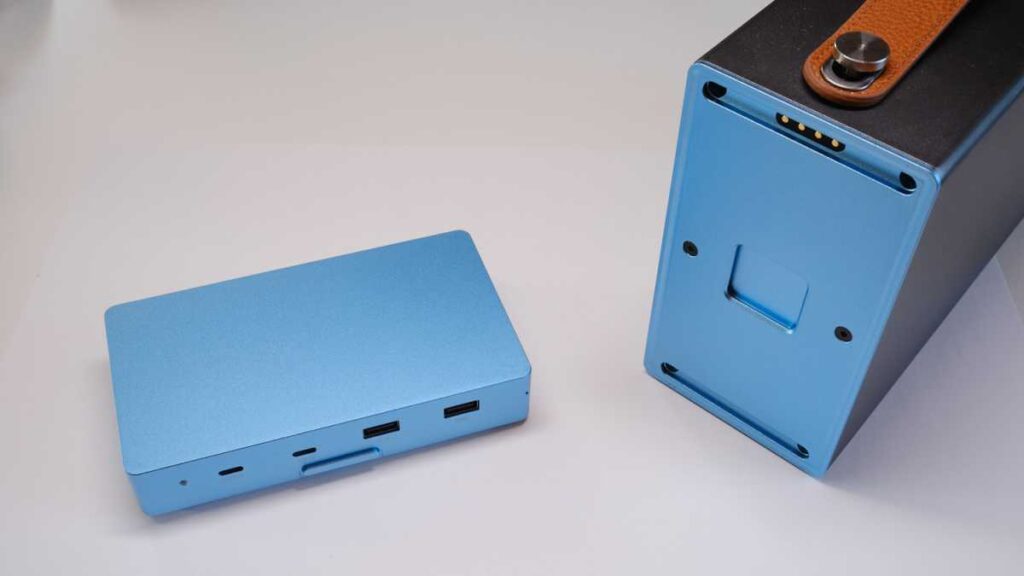FJDynamics Pony 500 review: Modular power

Expert’s Rating
Pros
Compact dimensionsModular designStable metal housing according to IP4XGood loading times
Cons
No display of battery cell healthIncluded power adapter gets very hot when chargingLong charging time
Our Verdict
If you are looking for a compact but huge power bank and don’t need the many connections of a power station, the Pony 500 is a good choice. Some users will not like that the Pony 500 is missing a way to see the health of the cells, but the charging speed meets expectations, and the price is good for such a large, compact power bank.
As the name implies, FJDynamics’ Pony 500 houses a 504-watt-hour (Wh) battery. FJDynamics uses a lithium nickel manganese cobalt oxide (NMC) battery that allows the Pony 500 to be more compact and usable in a wider temperature range. A lithium iron phosphate battery (LiFePO4), which is used in many power banks, lasts longer.
The Pony 500 is clean and cool looking, with a housing made of an aluminum alloy that is resistant to shock, splash water, and dust and has a protection class of IP4X. It weighs just under 8 pounds (3.6 kilograms) and measures 8.7 by 5.7 by 3.2 inches (22 by 14.5 by 8.3 centimeters). The leather carrying handle is a nice touch.
To promote its portability, the Pony 500 has only three ports, all of which can be used to charge devices or to charge the Pony 500 itself. One port is a 100W USB-C port, while the other two are XT60 ports that are used with remote-controlled devices such as drones. The XT60 ports can also be used with the 120W 18V Lightweight Folding Solar Panel offered by FJDynamics to charge the Pony 500, but be careful with the XT60 connections, because they are only designed for 46V to 58V. FJDynamics was not able to accommodate a charge controller in the compact housing, but it is being planned as an accessory.
To provide connectivity flexibility, the Pony 500 comes with a connection module that attaches to the back of the device. It has two additional USB-C ports (65W and 100W) and two USB-A ports (18W each). The connection module snaps into the main housing and can be easily removed again by pressing a release button. The modular concept allows for further options in the future, but the manufacturer has yet to announce any plans for this.
The rear module is detachable, which can be handy in a mobile situation where you need to whittle down your load and don’t need multiple connectors.
Thomas Bergbold
The on/off switch and a five-stage LED display for the battery capacity are located on the front below the connections. To switch it on, you have to hold down the button for about a second. If you forget to switch it off, the Pony 500 turns off automatically after a few minutes.
However, lithium-ion batteries in general require careful handling. Users should not completely discharge them and, if possible, not charge it to 100 percent too often. Fully discharging and recharging a lithium-ion battery puts excessive wear on it. FJDynamics offers a 36-month guarantee on the Pony 500, which seems a little short if you’re using the device constantly and putting more wear and tear on the battery.
When charging via USB-C for 30 minutes, I charged an iPhone 15 by 49 percent, an iPad Pro by 33 percent, and a MacBook Air by 39 percent. The Pony 500 itself can be fully charged within five hours using the included USB-C power adapter, but the power adapter gets very hot. The power supply has added value–it delivers a maximum output power of 100 watts and has two USB-C and two USB-A ports.
Should you buy the PJDynamics Pony 500?
With its compact and modular design, the Pony 500 stands out from the crowd of competitors and the price is slightly below comparably large power stations. However, FJDynamics has also forgone longer-lasting LiFePO4 battery technology in favor of an NMC battery that allows for a smaller size. The Pony 500 does pack a lot of power, and the additional ports on its power adapter are a nice touch.
The power adapter includes a set of ports for charging devices.
Thomas Bergbold
This article originally appeared on Macwelt and was translated by Roman Loyola.
Mobile Phone Accessories
